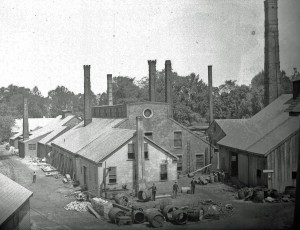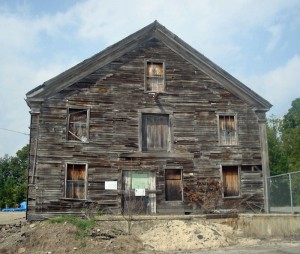College students tackle Plymouth Rubber site
By Jay TurnerAs a professor of civil engineering technology at Wentworth Institute in Boston, Jack Duggan is constantly on the lookout for “real world” examples that he can incorporate into his courses as teaching and learning tools.
So when Duggan was told about a 40-acre brownfield site that’s being targeted for redevelopment in Canton, he was immediately intrigued and thought it had “senior capstone project” written all over it.
“For us, this was a really great site because there are so many different features and all of these different issues that have to be taken into account,” said Duggan of the historic factory site off Revere Street — a location known to residents as the Plymouth Rubber property.

The Revere & Son Copper Rolling Mill, birthplace of the copper industry in America (Archival photo courtesy of the Canton Historical Society)
Once the home of Paul Revere’s copper rolling mill, the land had been used as a manufacturing center for more than 200 years when it was purchased at auction by the Napleton Company in 2006. The Illinois-based company has since made several attempts to rezone the property as a mixed-use development and apparently has a new site plan in the works that could go before voters at the next town meeting.
While the specifics of the new proposal have not been revealed, previous plans have called for a mixture of condominiums and small retail establishments in addition to public parkland and the preservation of the two historic structures on the property: a 19th century barn and rolling mill.
In the meantime, a pair of alternative proposals were unveiled earlier this month at Wentworth as two groups of students in Duggan’s senior design course outlined their own ideas for the site in a presentation attended by Planning Board members Jeremy Comeau and George Jenkins.
Suffice it to say, both five-member teams left a positive impression on the two Canton planners, who had provided the students with background information and had also taken them on a tour of the property in July. It was Comeau, in fact, who had originally suggested the site to Duggan after agreeing to speak to one of his classes about subdivision regulations last spring.
“I think the good thing about this project is that the students are not residents [of Canton],” noted Comeau. “They’re not the developer. They don’t work for the developer. The only thing they are working toward is a good grade and to graduate.”
And this being their senior capstone project — a requirement in all engineering programs — the students strove for professional-level quality, taking on the role of an engineering design firm and factoring in everything from project costs and scheduling to environmental sustainability to ethical issues.
Ultimately, the two groups that chose the Canton site settled on markedly different designs, with one group opting for a retail shopping center, including a Whole Foods market, and the second group deciding on a biotech office building on the north end of the site with the majority of the property being set aside for parkland and other passive recreation, such as walking trails.
As for the two historic structures, Duggan said the first group suggested that the rolling mill be converted into a restaurant and the barn be restored as a museum, while the second group decided to use the barn as a petting zoo and chose to ignore the rolling mill altogether.
The students also designed their own access points, with the first group opting to use Neponset Street as an entrance to the plaza via a bridge over the Neponset River.
In addition, the students were required to take into account the nature of the soils on the property and to design their foundation systems accordingly. They also looked into the nature and amount of contamination on the property and devised a soil management plan based on data they obtained from the state Department of Environmental Protection.
As a former DEP engineer, Duggan personally found the site to be a fascinating case study, and he took the opportunity to educate his students about various environmental policy issues, including cleanup standards and use limitations. At the same time, Duggan said the Plymouth Rubber property is “so complicated” from an environmental standpoint that he decided to have students address contamination on just one part of the site.
For the most part, however, the students’ designs were guided by realistic constraints and boundaries — to the point where both groups “dramatically changed their plans” after seeing the site for themselves, according to Comeau.
Duggan said the one area that the students should have perhaps been more considerate of was traffic — a hot-button issue that matters to residents, especially those who live in the area. However, he appreciated the fact that the students were not bound by the “history, the politics, and the contentiousness of the site.”
Reflecting on the students’ final projects and presentations, Duggan was both impressed with their work and excited about the potential for future use of the Canton site in his courses.
“We definitely plan on using [the Plymouth Rubber site] again,” he said. “Projects like this one better prepare my students for what they will experience in the real world upon graduation. This opportunity [with Canton] has really given us a pilot test on where we would like a lot of our capstone projects to be in the future.”
In addition to finding a new design idea for his students, Duggan is also pleased to have found a valuable resource in Comeau, not to mention a new set of zoning bylaws and subdivision regulations to use in his courses, courtesy of the town of Canton.
Duggan, who learned about the documents from some of his municipal planning students, believes that Canton went the “extra mile” in drafting the regulations and he was happy to adopt them for future use at Wentworth.
“For us this was just absolutely perfect,” said Duggan, “because not only did we get students to work on real regulations at a real property, we also got Jeremy who was very generous with his spare time to share his knowledge and insight on the nuances and interpretation of the regulations and bylaws. You can’t do any better than that.”
Short URL: https://www.thecantoncitizen.com/?p=15864











